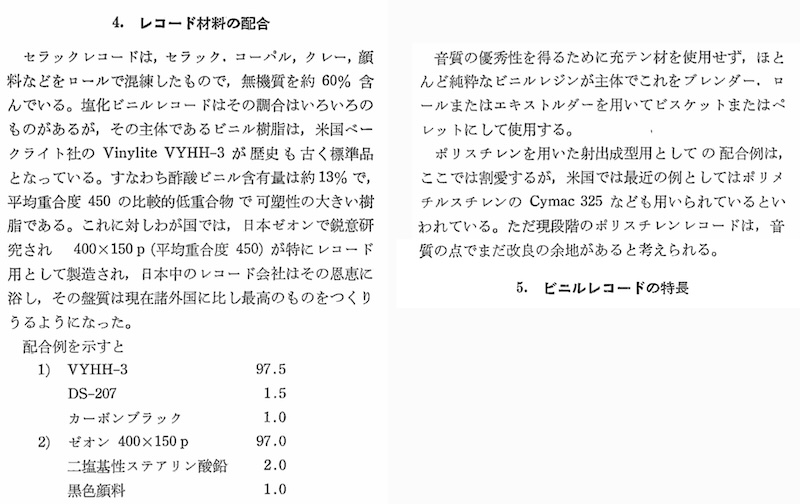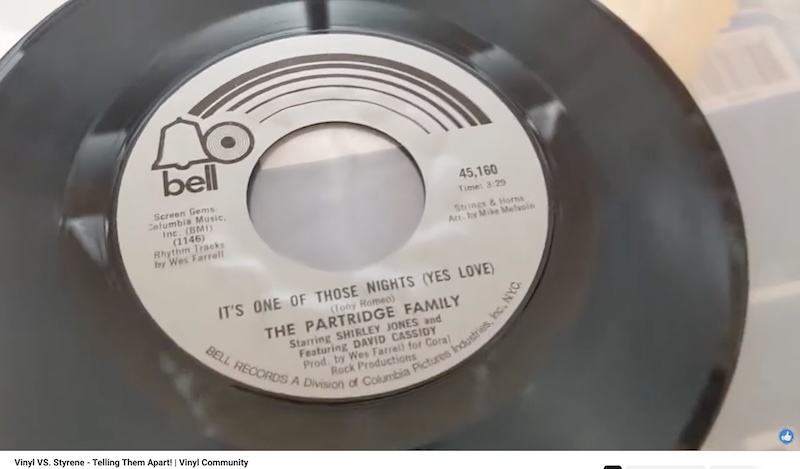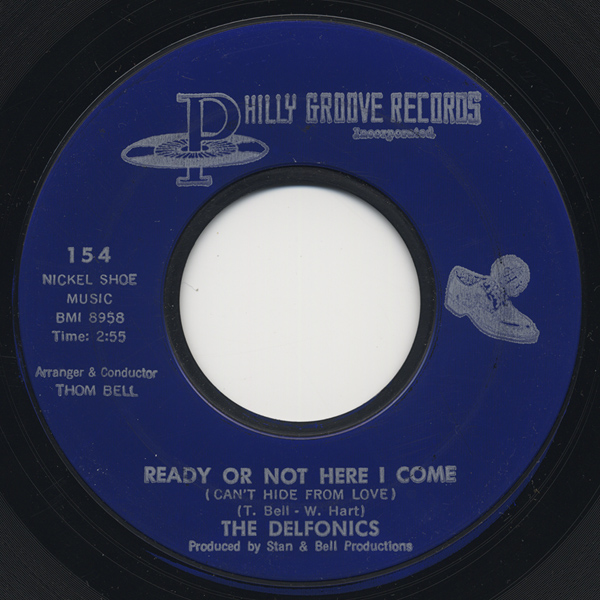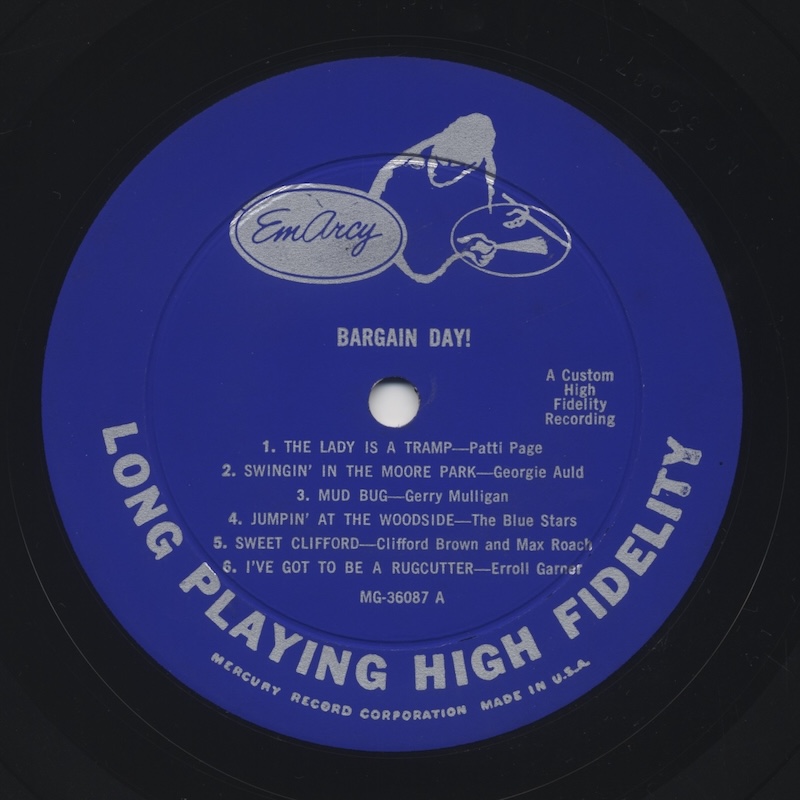今回は、SNS 上でみかけたあるレコードの特徴をきっかけにして、戦後のレコード製造工程や原材料の歴史を改めて調べてみた、そんな記録の前編です。
This first installment is my attempt to revisit the post-war history of record-manufacturing processes and materials—sparked by an intriguing feature I noticed on a post on social media.
Contents / 目次
Preface / はじめに
レコードは何から作られているか。レコードのプレスはどのように行われているか。なんとなくでもご存じの方は多いでしょう。
What are records made of, and how exactly are they pressed? Many readers probably already have at least a rough idea.
レコードの主たる原材料として使われてきたものには、シェラック、ベークライト、ポリ塩化ビニル、ポリスチレン、PET などがあります。当然、圧倒的に主流なのはポリ塩化ビニルです。
The principal raw materials that have been used for records include shellac, Bakelite, polyvinyl chloride (PVC), polystyrene and PET. Unsurprisingly, PVC has long been the overwhelmingly dominant choice.
また、レコードの製造(プレス)方法としては、圧縮成形が主流で、射出成形のものもあります。
As for manufacturing methods, compression molding is the mainstream process, although injection-molded records do exist.
Record Manufacturing & Ingredients / レコードの製造方法と原料
まずは、原材料と製造方法の関係を復習してみましょう。
Let’s start by reviewing how raw materials and manufacturing methods are related.
Compression Molded Records / 圧縮成形レコード
マイクログルーヴ時代以前(〜1948)の78回転盤、日本では SP 盤と呼ばれますが、1895年以降、天然樹脂である シェラック(ラックカイガラムシの雌の分泌物)に様々な充填材を混ぜて製造されたものがほとんどでした。
Before the microgroove era (up to 1948), 78-rpm discs – known in Japan as “SP” records – were almost always made by mixing the natural resin shellac (a secretion of the female lac bug) with various fillers, a practice that began in 1895.
1930年代〜40年代の 放送局用トランスクリプション盤(16インチ 33⅓回転)や、78回転盤テストプレスの一部は、当時の民生用レコードで使われていたシェラックではなく、当時最先端の人工合成樹脂であるビニライト(Vinylite、当時は Union Carbide & Carbon 社の登録商標)などで製造されていました。
During the 1930s and ’40s, however, certain 16-inch 33⅓-rpm transcription discs for broadcasters and some 78-rpm test pressings were made not from shellac but from cutting-edge synthetic resins such as Vinylite (then a Union Carbide & Carbon trademark).
そして、1948年に登場したマイクログルーヴ盤 が主流となってからは、レコードは一般的に、上述のビニライトに代表される人工合成樹脂、ポリ塩化ビニル (polyvinyl chloride, PVC, 塩化ビニルと酢酸ビニルの共重合体) を主とした原材料で製造されています。
With the advent of micro-groove LPs in 1948, records have generally been manufactured from synthetic resins typified by Vinylite—in other words, from polyvinyl chloride (PVC).
PVC 自体は透明で、通常はカーボンが配合されているため黒色をしていますが、無色透明のものからさまざまな色がつけられたものまであります。
PVC itself is transparent; it appears black because carbon black is normally added, although everything from clear to vividly colored pressings exists.
さらに、純粋なポリ塩化ビニルは柔軟性と弾性に欠けるため、可塑剤 (plasticizer) も配合されます。LP レコードを両手で支えて盤をゆするとたわむように動くのは、可塑剤のおかげです。そして、柔軟性と弾性のおかげで、レコード針の接触による摩耗を軽減しつつ、忠実再生ができるようになっています。
Because pure PVC lacks flexibility and resilience, plasticizers are blended in. The gentle flex you feel when you wag an LP between your hands is thanks to these additives, which also reduce stylus wear and allow faithful playback.
以前 別記事中のコラム で紹介しましたが、高分子学会 の論文誌 1959年8巻7号 に、「人工高分子のレコード」という解説記事が掲載されています。著者は日本グラモフォンの柳本孝男氏で、1957年に京都大学で理学博士号を授与された方のようです。
I found an interesting technical article by chance: “Synthetic Polymer Records” (1959), published in the Vol. 8, No. 7, the Journal of The Polymer Science (Jpaan). The author is Takao Yanagimoto of Nippon Gramophone, who received the Doctor of Science at Kyoto University in 1957.
1959年、ちょうどステレオLPが登場した直後というタイミングでもあり、レコード材料の配合比率という観点から非常に興味深いデータが多く掲載されているほか、1950年代後半における日本、米国のレコード製造事情も垣間見られ、同時にヴァイナルレコードの基礎知識解説もある、簡潔にまとめられた非常に貴重な資料だと思います。
This article was written in 1959, just after the stereo records were introduced. It describes plenty of valuable information, from the viewpoint of vinyl record’s composition. It also is an overview of vinyl record production both in the US and in Japan as of 1959, as well as an outline of the fundamental technology of vinyl records.

source: J-STAGE DOI https://doi.org/10.1295/kobunshi.8.364.
当時の米国では、ベークライト社の Vinylite VYHH-3 が、日本では、ゼオン 400×150p が、それぞれ広く使われていることが解説されている。同時に、ポリスチレン製レコードについても触れられている
This article explains the composition of the vinyl compound as of the middle-late 1950s: Bakelite Corporation’s Vinylite VYHH-3 widely used in the US, while Japan Zeon’s 400×150p used in Japan. Also there is a brief mention of polystyrene records.
その他、多くの場合、滑剤 (lubricants) や 帯電防止剤 (antistatic agents)、二塩基性ステアリン酸鉛 (DLS, dibasic lead stearate) などの 安定剤 (stabilizer) なども少量混合されます。
Small amounts of lubricants, antistatic agents and stabilizers such as dibasic lead stearate are also commonly added.
これらの原材料によって製造された、いわゆるポリ塩化ビニル製レコード(そしてかつてのシェラック製レコード)のほぼ全ては、圧縮成形 (compression molding) という方法で製造されます。各社秘伝の配合の材料(ビスケット)と、完全に乾燥させたレーベル用紙をプレス機にセット、150〜160℃程度の熱を加えながら 130〜230kg/cm2G 程度の圧力で上下に挟み、その後一気に30℃程度まで温度をさげることでプレスを行います。
Virtually all PVC records—and earlier shellac discs—are pressed by compression molding. A biscuit of each plant’s proprietary compound and two perfectly dried labels are placed in the press, squeezed between the heated stampers at roughly 150 – 160 °C and 130 – 230 kg/cm2G, then rapidly cooled to about 30 °C.
そして、圧縮成形によってはみ出した部分を、レコードを回転させながら専用のカッターでトリミングし、レコードが完成します。
Any flash that oozes out is then trimmed off while the record spins on a dedicated cutter, leaving a finished disc.
切り取られた端材はプレスに再利用されます。
The trimmed scrap is recycled back into the press compound.
最後に、目視や再生チェックによる品質検査が行われ、不合格となったものはレーベル部分がくり抜かれたのち、やはり再利用に回されます。
Finally, each record undergoes visual and sometimes play inspection; rejects have the label punched out and are likewise recycled.
このような一連の作業を経て、レコードが作られます。
Through this sequence of steps a vinyl record is born.
How a vinyl record is made. pic.twitter.com/ZuIkIbUhm8
— HOW THINGS WORK (@HowThingsWork_) October 6, 2024
Injection Molded Records / 射出成形レコード
一方、中古レコードを蒐集するようになると、米国製のレコード、特に45回転盤で「スチレン盤」を目にする機会があります。これは、ポリ塩化ビニルとは異なる合成樹脂、ポリスチレン (polystyrene, PS) を主とした原材料で製造されたレコードです。
On the other hand, collectors of used records often encounter American 45s made of “styrene”. These discs are molded mainly from polystyrene (PS), a resin different from PVC.
ポリスチレンは、安価かつ加工しやすい特徴があり、最も身近なプラスチックで、例えば発泡スチロールやプラモデルなどもポリスチレン製です。
Polystyrene is inexpensive and easy to process; it is the familiar plastic found in everything from foam packaging to model-kit sprues.
スチレン盤LPは通常のポリ塩化ビニル盤LPに比べて柔軟性がなく(盤をゆすってもあまりたわまない)、聴き込まれた中古盤は白濁していることが多いです。
Styrene LPs are noticeably less flexible than vinyl LPs, and well-played copies often develop a milky haze on the surface.
レコードの端を軽く弾くと、通常のポリ塩化ビニル盤は鈍い音がするのに対し、スチレン盤では少し高い響くような音がする、そんな違いもあります。
If you flick the edge of a record, a vinyl disc emits a dull thud, whereas a styrene disc produces a slightly higher, ringing tone.
また、ポリ塩化ビニルに比べてポリスチレンは比重が小さいため、同一寸法・厚みの場合は少し軽くなります。
Also, because PS has a lower specific gravity than PVC, a styrene disc is a little lighter than a vinyl disc of the same dimensions.
スチレン製レコードの多くは、射出成形 (injection molding) という方法で製造されます。(ポリ塩化ビニルより粘度が低い)ポリスチレン樹脂を主とする原材料を熱し、液状にした上で、スタンパーが設置された閉鎖空間(モールド)に高圧で流し込み充填、冷却したのちレコードを取り出した上で、別途レーベル用紙をレコードに貼り付けることで完了します。
Most styrene records are produced by injection molding: molten resin is injected at high pressure into a mold fitted with stampers; after cooling the disc is ejected and the paper labels are applied separately.
レーベルはプレス後に貼り付けられるため、いわゆる深溝(Deep Groove、DG)やリング上の段差はレーベル上に表れることがありません。また、レーベルの縁を指でなぞると、プレス盤のものに比べて、紙の縁がより感じられる、という違いもあります。
Because the label is added after pressing, no deep-groove or concentric ring appears on the label surface. Running a fingertip around the rim, you can clearly feel the paper edge—more so than on a pressed vinyl disc.
時には、レーベルの下に気泡が入っていたり、そもそもレコードから剥がれかけている中古盤もよく目にします。
Styrene discs sometimes show trapped air bubbles beneath the label, or labels that are partially peeling away.

It’s One Of Those Nights (Yes Love) c/w One Night Stand / The Partridge Family (Bell 45160, 1972)
source: “Vinyl VS. Styrene – Telling Them Apart! | Vinyl Community”, That Vinyl Channel, YouTube.
レーベル紙の下に気泡が入り込んでいることで、プレス後レーベルが貼り付けられた、すなわちスチレン盤であることを示している

Piano Reflections / Fran Thorne (Transition TRLP-27, 1956)
photo from the Discogs entry
Transition レーベルのオリジナル盤は一貫してスチレン射出成形盤だったようで、レーベル上に深溝 (DG) がなく、またレーベル縁がはがれかけているのがわかる
なかには、紙のレーベルではなく、プレス直後に盤に直接インクで印刷したスチレン盤シングルなんてのもあります。
Some styrene singles dispense with paper labels altogether and are printed directly on the disc surface immediately after pressing.

Ready Or Not Here I Come c/w Somebody Loves You / The Delfonics
(Philly Groove 154, 1968)
2006年に当ブログに掲載 した手持ちのシングル盤
レーベルのエッジに青いインクがはみ出しており、盤に直接印刷したタイプと判断できる
プレス工場は Bestway Products で、1946年創業
同社創設者の Al Massler 氏が、スチレン射出成形によるレコード製造方法を開発した先駆者
また、射出成形による製造では、プレスが完了した時点でレコードの形状をしており、圧縮成形の時のようにはみ出した部分をトリミングする必要がありません。
Because a disc leaves the injection mold already finished to shape, no flashing needs to be trimmed off.
以下は、レコードプレス用ではありませんが、一般的な射出成形機の動作原理を解説した動画です。
The videos below are not specific to record pressing, but they illustrates how a conventional injection-molding machine operates.
射出成形によるレコードプレス機を捉えた過去の写真・動画・資料は、一般的な圧縮成形レコードプレス機とは異なり、なかなか見つかりません。幸い、以下の 2023年に撮影された YouTube 動画では、射出成形の巨大な自動LPレコードプレス機が捉えられています。
Historical footage of injection-molded record presses is scarce, yet a 2023 YouTube clip fortunately captures a huge automated LP press working by this method.
プレス直後にはレーベルがなく、その後レーベル自動貼付を行う機械が稼働しているのが確認できます。
The discs emerge unlabeled, and an automatic labeler applies the labels downstream.
ちなみに、現代ではもはや、ポリスチレンを使ったレコードプレスは行われていません。上の動画の Green Vinyl Records では、ポリスチレンではなく ポリエチレンテレフタレート、いわゆる PET(そう、ペットボトルの PET です)を主原料として射出成形で製造しています。
By the way, Today no one presses polystyrene records; the Green Vinyl Records plant featured in the clip injection-molds discs from PET – the same material used for beverage bottles.
同様に、Sonopress 社の EcoRecord も、同様に PET の射出成形方式でプレスされたレコードで、2024年に入り一部で話題になっています。下の動画でも、スタンパーのセット〜射出成形〜レーベル自動貼付の一連の流れが捉えられています。
Likewise, Sonopress’s EcoRecord, also injection-molded from PET, drew attention in 2024. The below clip also features the procedure from setting up stampers, injection molding, to automatic labeling.
Abbey Road Studios の錚々たるエンジニア、Lucy Launder、Geoff Pesche、そして Miles Showell の3氏が、Sonopress 社の工場を訪問した、というプレス記事も話題になりました。
A widely discussed press piece reported that three eminent Abbey Road Studios engineers—Lucy Launder, Geoff Pesche and Miles Showell—paid a visit to Sonopress’s factory.
Compression Molded Styrene Records…? / 圧縮成形スチレンレコード…?
で、やっと冒頭の話に戻ります。@zmuku さんが X (was: Twitter) 上に投稿されていた、EmArcy / Mercury MG-36081 の写真です。
Which brings us back to the opening topic—a set of photos of EmArcy/Mercury MG-36081 posted on X (formerly Twitter) by @zmuku.
Dick Johnson Quartet – Music For Swinging Moderns (Emarcy / EmArcy – MG-36081)(1956) 購入。レーベルはMercury Emarcy Jazz。Discogsでみると、Styreneの表記。レコード盤の材質がスチレンとのこと。そういえば少し違うかな。 pic.twitter.com/QPVAjtMdjL
— muku (@zmuku) September 15, 2024
手持ちの10インチ盤が同じような質感です。ランアウトのスタンプが凹凸が深い感じです。ついでにジャケット裏面も。 pic.twitter.com/BfgpvnHSMz
— muku (@zmuku) September 15, 2024
我が家にも、レーベルとジャケ裏にこの3本線が入った Mercury / EmArcy 盤がそこそこあります。なんとなく、オリジナルではなく後年の廉価リイシューの印なんだろう、と思って、あまり深く考えてなかったのですが。
I have several Mercury/EmArcy discs at home bearing the same triple-line motif on the label and back cover, and I had always assumed they were later budget reissues without giving them much thought.
同盤の Discogs エントリ に「Styrene」と書かれているのは本当なんだろうか。確かに 通常の EmArcy ファーストプレス(RCA Victor Indianapolis プレス)とはまるで違う質感の盤ではあるのですが。
Is it really accurate that the Discogs entry for this release labels it as “Styrene”? Admittedly, the record’s feel is completely different from that of the standard EmArcy first pressing made at RCA Victor’s Indianapolis plant.
レーベルの深溝 (DG) の形状も、当時 Mercury が使っていた RCA Victor Indianapolis 工場や MGM Bloomfield 工場のものと異なります。さらに、スピンドル近辺に段差が追加されています。つまり、これらの工場プレスではないか、あるいは同じ工場でも別ラインのプレス機で製造されたものなのでしょう。
The deep-groove profile also differs from what RCA Victor’s Indy or MGM Bloomfield plants used, and there is an extra ridge near the spindle hole, suggesting a different plant—or at least a different line within the same plant.

Bargain Day! / V.A. (EmArcy MG-36087)
1959年頃のリイシュー、Mercury “EmArcy Jazz” 楕円ロゴに3本線が入るほか、深溝 (DG) の形状が異なり、スピンドル近辺に段差がある
マトリクスには FF-S 手書きが追加

Bargain Day! / V.A. (EmArcy MG-36087)
1957年末に通常リリースのオリジナル、RCA Victor Indianapolis プレス
Questions So Far / 現時点での疑問
それにしても、疑問です。
I still find myself full of questions.
(1) もし、Mercury / EmArcy にみられるこの3本線入り廉価リイシューが スチレン盤 なのだとすると、なぜレーベルに深溝(DG)があるのでしょうか。スチレン盤でも、射出成形ではなく圧縮成形のものがあったということなのでしょうか?
(1) If these triple-line budget reissues on Mercury / EmArcy are really styrene discs, why do their labels have a deep-groove (DG) ring? Could it be that some styrene discs were compression-molded rather than injection-molded?
(2) そもそも1950年代〜1970年代当時、米国の各レーベルや各プレス工場は、どういった背景でリリースごとにポリ塩化ビニル盤とスチレン盤を使い分けていたのでしょうか。両者には製造工程やコストの面でどのような違いがあったのでしょうか。
(2) During the 1950s-70s, what drove U.S. labels and pressing plants to choose PVC for some releases and styrene for others? How did the two materials differ in production workflow and cost?
(3) 米45回転スチレン盤は大量に存在していたのに、米スチレンLP盤はそれほど多くなかったのはなぜなのでしょうか。
(3) Styrene 45-rpm singles were plentiful in the U.S., yet styrene LPs were far less common—why?
(4) 欧州では1970年頃から射出成形のポリ塩化ビニル45回転盤が存在するのに、なぜスチレン盤は採用されなかったのでしょうか。そして逆に、なぜ米国では射出成形のポリ塩化ビニル45回転盤が存在しなかったのでしょうか。
(4) In Europe, injection-molded PVC 45s have existed since about 1970, yet styrene discs were never adopted there. Conversely, why did the U.S. never embrace injection-molded PVC 45s?
@zmuku さんの投稿をきっかけにして、今まであまり深く考えていなかったこれらのことが、急に気になり出したのです。
It was @zmuku’s post that suddenly made me curious about all these issues I had barely considered before.
Researching from the different view(s) / 違う側面から調査開始
そこで、いつものように、過去の音楽業界雑誌、技術紀要、特許文書などをかたっぱしから調べてみることにしました。
So, as usual, I started digging through old music-industry magazines, technical bulletins, patent documents, and anything else I could find.
レコードの製造工程や原材料に関する記事が当時の雑誌に載っていないか、丹念に探してみると、1950年代前半に書かれた連載記事を見つけることができました。また、興味深い日本での学術論文や学会誌解説記事なども見つかりました。いままでは目にも留まらなかった(あるいは読み飛ばしていた)ものばかりですが、違う視点やキーワードから探してみると、意外とあっさり目につくものですね。
Carefully searching for articles on manufacturing processes and raw materials, I unearthed a serialized feature from the early 1950s. I also discovered fascinating Japanese academic papers and society-journal articles. They had never caught my eye—perhaps I had skimmed past them—yet with new keywords and angles they surfaced surprisingly quickly.
また、当時の米国におけるレコード技術研究開発の先端を走っていた RCA Victor、同社の社内技術紀要にも、材質やプレス工程について詳しい解説記事が見つかりました。
I also found detailed discussions of materials and pressing techniques in RCA Victor’s in-house technical reports; the company headed record-technology R&D in the U.S. at the time.
これらを読み解き、時系列に整理していくことで、なぜ射出成形によるスチレン盤が登場したのか、各社にどんなメリットがあったのか、それぞれの会社はどのようなスタンスで取り組んでいたのか、などについて、全く新しい知見を得ることができました。
By analyzing these sources and arranging them chronologically, I gained brand-new insights into why injection-molded styrene discs emerged, what advantages they offered each company, and how individual firms approached the technology.
意外や意外、「圧縮成形 vs 射出成形」は、米2大レーベル間のバトルの様相を呈していた時期もあったようなのです。
To my surprise, the rivalry between compression molding and injection molding at times resembled a turf war between two major U.S. labels.
さらに、いままであまり深掘りしてこなかった、Mercury の3本線の表す意味について、説得力のある仮説を立てることができました。
I also managed to develop a convincing hypothesis about what Mercury’s three-line motif signifies—something I had never examined in depth before.
次回から、これらについてみていこうと思います。乞うご期待。
Starting next time, I’ll dig into all of these topics—stay tuned!
» 続き / Sequel: “How Records Were/Are Manufactured (2)” »




Hello! First of all, huge thanks for such an amount of work you’ve made on Mercury Records. This is absolutely amazing job.
My guess on chronology goes like that.
Mercury used to press records on RCA Victor, then only stereo albums were pressed there with mono pressed somewhere else (many of them are MGM pressings). But in 1958 they buy an old pressing plant in Indiana (Richmond), that previously was used by Decca. Since Decca also used styrene pressings in mid 50’s (I’m not sure it’s styrene, but definitely not vinyl, since it’s bright sound when tinkling and has not flexibility) I guess some of the records were pressed there using that material. Seems like there was some special press for these ‘styrene’ records, since they have not only DG, but these little ring on both sides. I haven’t seen such rings on any other records.
No new albums were released originally on this ‘styrene’, used only for reissues. Therefore many different lacquers were used, with different types of matrix etchings. I have some Erroll Garner ‘Garnering’ album, which is a ‘styrene’ pressing, but has 60’s type of matrix, used on Richmond plant.
Best,
Alexander
Hi Alexander-san, thanks for your comment.
I do agree most of what you have noted here. Now I’m writing the (lengthy) sequel articles about compression vs injection molding, and vinyl vs polystyrene, which would be more chlonologicallly interesting. Stay tuned for a while! 🙂
Kohji
that sounds exciting, I have very limited knowledge of injection molding.
One thing to add, that your comment did not mention.
Richmond plant (which was originally for Decca) did compression molding with vinyl for most of the releases. It could be that some of the Mercury’s styrene releases were manufactured there, but I guess Mercury outsourced to some other plants for such styrene reissues and for budget subsidiaries.
Also, I believe we can’t completely trust only the matrix stamps/etchings. As a matter of fact, I have several EmArcy reissues (with Mercury/EmArcy oval logo, with that “|||” mark on the label), which has mid-1950’s RCA Victor Indy type of matrix (!). I don’t think it means this particular styrene disk was pressed at the Indy plant, of course.
Please correct me if I’m wrong here. Doesn’t it just mean that laquer or mother or stamper was made initially at RCA plant and then delivered back to Mercury and consequently used to make a pressing elsewhere? Therefore it contains this initial RCA Indy type of matrix, but was actually pressed later somewhere else.
I have several copies like that, for example Mulligan MG-36056 original and styrene pressing, both having Indy matrix and even ‘I’ symbol, that, as I understand, stands for RCA Indi plant.
One more question – maybe I missed it, but do you have any update on what FF, F-S and other alike etchings mean? I read you think they stand for the name of the mastering engineer? Thought so too, but I have some styrene pressings with lacquer identical to the original pressing, but that have this FF sign. If the same lacquer was used then what was the job of this mysterious FF man?
Yes, I guess the same way: they (mothers/stampers) were back to Mercury then used elsewhere. I’m going to mention this in the coming articles.
Also, I think I’m going to deal with the possible meaning of the “FF” and “FF-S” etchings in the coming articles as well.
Thank you, looking forward to this revealing read. Best
Hi, I’ve posted the sequels about the history of record moulding and resins for records, but not yet on the Mercury styrene LPs and “FF-S” etchings, which will be posted as the final episode.
Hi Kohji,
I hope you’ve been well! I’ve been following your recent posts, and they’re excellent.
This is Shane from the ol’ university. We connected on Slack some time ago, though I completely understand if you don’t remember. I just wanted to express how much of an honor it was to attend your lecture.
Hi Shane-san, wow, how could I forget you and “that” great time we had (along with many others)? I really miss all those students of mine. I really wish we will have time soon to hang out and talk a lot. Take care! Kohji
はじめまして。大変学習価値の高い情報を有難う御座います。
デッカやコーラルのLPで、”non-breakeable” とは書いておらず、固くて爪先で弾くとカンカンと音が響くうえに盤面全体が振動する盤をよく見かけましたので、これは一体何の材質だろうか?と永年気になって居りました。
デッカとコーラルも、スチレン樹脂になりますでしょうか?
はい、1960年初頭までの U.S. Decca や Coral がスチレン製である、というのは大変有名な話のようです。当初は78回転盤用に使われていた「Deccalite」という商標ですが、LP時代に入るとスチレン製LPに同じ呼称「Deccalite」を使っていたそうです。すなわち、Deccalite は特定の材質名ではなく、non-breakable だったり「我が社のなんかスゲー新素材(笑)」くらいのブランド名だったようですね。
残念ながら、私の手元には1枚もないのですが、海外のオンラインフォーラムでは Decca のスチレン製LPに関する議論を比較的多く目にします。そして、当時の他レーベルのスチレン盤とは違ってDecca スチレン盤の品質の高さ(再生音質の素晴らしさ)を賞賛するオーディオ評論系の記事すらありました。
ちょうど先日、Mercury のスチレン盤について深掘り調査した最終回(第6回)を公開しましたが、その中で、Deccaのスチレン盤に関するコラムとして、その辺りについても触れたところでした。
参考になれば幸いです。
大変勉強になりました!
早速続きも拝読させて戴きます!